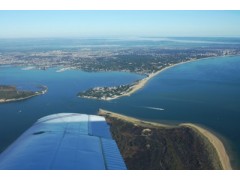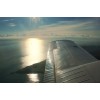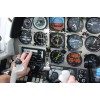PAT has been one of the very few professional flight schools to take seriously the private pilot who, maybe for business reasons, needs to acquire an Instrument Rating.
Professional Air Training Ltd is owned by husband and wife team Linda and Anthony Mollison who both have business backgrounds. As such, they understand time constraints and other business pressures and will try to be as flexible as possible, in order to develop a timetable that suits you, whilst giving you the optimum chance of completing your training in a timely and cost-effective manner. This includes training on a part-time and weekend basis.
PAT is proud of its success in helping private pilots to gain their ambition of holding an Instrument Rating. After graduation it is recommended that pilots join PPL/IR Europe, a network of PPL/IR holders (or intended PPL/IR holders) which provides vocal support for the PPL/IR across the continent, and is strongly supported by Professional Air Training Ltd. Contact Sali Gray, the PPL/IR Network Membership Secretary at:
E-mail: memsec@pplir.org
STOP PRESS:
Changes!
A dedicated EASA working group looked at the future of instrument flying qualifications for European airspace.
The proposals for the IR, which were incorporated into EASA in April 2014, include a reduced and more relevant theory syllabus (80 hours instead of 200), and two new ratings, the En-Route IR (EIR) and the Competency based IR (CBIR). No changes are proposed to the standards required, either for the ground exams or for the Instrument Rating flight test.
En-route Instrument Rating (EIR)
This course consists of 15 hours instruction for a single engine EIR, or 16 hours instruction for a multi engine EIR (at least 4 of which are to be completed in a multi-engine aircraft. At least 10 of the training hours must be completed at an Approved training Organisation (ATO). The skill test will be performed by an IRE. Revalidations will alternate:
- 6 hours IFR PIC in the last 12 months plus a 1 hour flight with an IRI
- Proficiency check in last 3 months of the rating currency with a CRE/IRR or an IRE.
The privileges of the holder of an EIR are to conduct flights by day under IFR in the en-route phase of flight, in an aeroplane for which a class or type rating is held. The privilege is extended to include flights at night if an EASA night rating is held.
The holder of an EIR shall only commence or continue a flight using an EIR if the latest met indicates that:
- the weather conditions on departure are such as to enable the segment of the flight from take-off to a planned VFR to IFR transition to be conducted in VFR conditions; and
- at the estimated time of arrival at the planned destination aerodrome, the weather conditions will be such as to enable the segment of the flight from IFR-VFR to landing to be conducted in VFR conditions.
In other words, take-off and landings must be carried out in VFR conditions; it is only the en-route section which can be carried out in IFR.
Competency-based Modular IR Course
If you have more than 50 hours PIC IFR please read the section below.
Otherwise, the CBIR course consists of training as follows:
- Single engine - 40 hours of which up to 25 hours may be carried out in an FNPTII, the rest in an aircraft
- Multi engine - 45 hours of which up to 30 hours may be carried out in an FNPTII, the rest in an aircraft
Credits against course hours
If you have completed flight instruction with an EASA IRI (A) or an EASA FI (A) holding the privileges to fly under IFR and IMC,
or have accumulated PIC IFR hours under a rating allowing you to fly under IFR and in IMC
- then you are allowed to apply up to 30 hours credit against the single engine course hours defined above (35 hours credit against the multi engine course hours defined above).
If you have completed flight instruction with an instructor who does not hold the above EASA qualifications (e.g. an FAA instructor)
- then you are allowed to apply up to 15 hours credit against the single or multi engine course hours defined above.
In any case, the flying training must include a minimum of 10 hours in an aeroplane at an ATO.
A minimum of 25 hours total instruction must be completed, including instruction outside an ATO.
The IRT & IRR are as for the current IR.
CBIR for pilots with more than 50 hours PIC IFR
If you have a current non-EASA IR and more than 50 hours PIC IFR, you do not actually have to do any training, ground or flying, towards obtaining an EASA IR. Rather, you are allowed to contact the CAA direct and book an IR skill test. We do not recommend this strategy. The UK (EASA) IRT is conducted in a particular way. Certain things are expected and the standard is high. Our experience is that even very knowledgeable and skilful IR pilots wishing to convert a non EASA IR need some training with an experienced local IR instructor who is fully versed on what is to be expected.
Ground studies
As stated above, the PPL/IR course for the EIR or the CBIR is 80 hours of theoretical knowledge instruction, although it is still possible to undertake the full 150 hour TK course. The main advantage of the longer course is that it includes an element of high performance aircraft instruction, for those pilots who wish to use their IR on a high performance aircraft.
Although other ground schools may run PPL/IR ground studies we strongly recommend the following school:
Ground Training Services (distance learning only):
e-mail: roger@gtserv.co.uk (contact Roger Henshaw)
Tel: +44 1202 580809
Although the course is run by distance learning, you will be required to attend a period of full-time training. Ground Training Services course consists of two distance learning modules, each followed by a one day full time brush-up course.
Flying Training
The single engined course is a 40 hour course consisting of 20 hours in our FNPTII simulator and 20 hours in our Beech Sierra complex single, less any credits which may apply to you.
The multi-engined course is a 45 hour course consisting of 25 hours in our FNPT II simulator and 20 hours in our Beech Duchess multi-engined aircraft less any credits which may apply to you. You need to have completed a multi-engine piston class rating course before you commence the multi IR course.
Both courses have the option of completing an extra 5 hours in the FNPTII and 5 hours less in the aircraft. This obviously reduces the price, but we feel that the extra hours in the aircraft give you a greater chance of a first time pass in minimum hours.
If your own aircraft is suitably (IFR) equipped, there is the possibility – and maybe the advantage - of using this aircraft for the IR flying. However, this option first needs a detailed discussion of the plus and minus points. Please contact us to talk it through.














